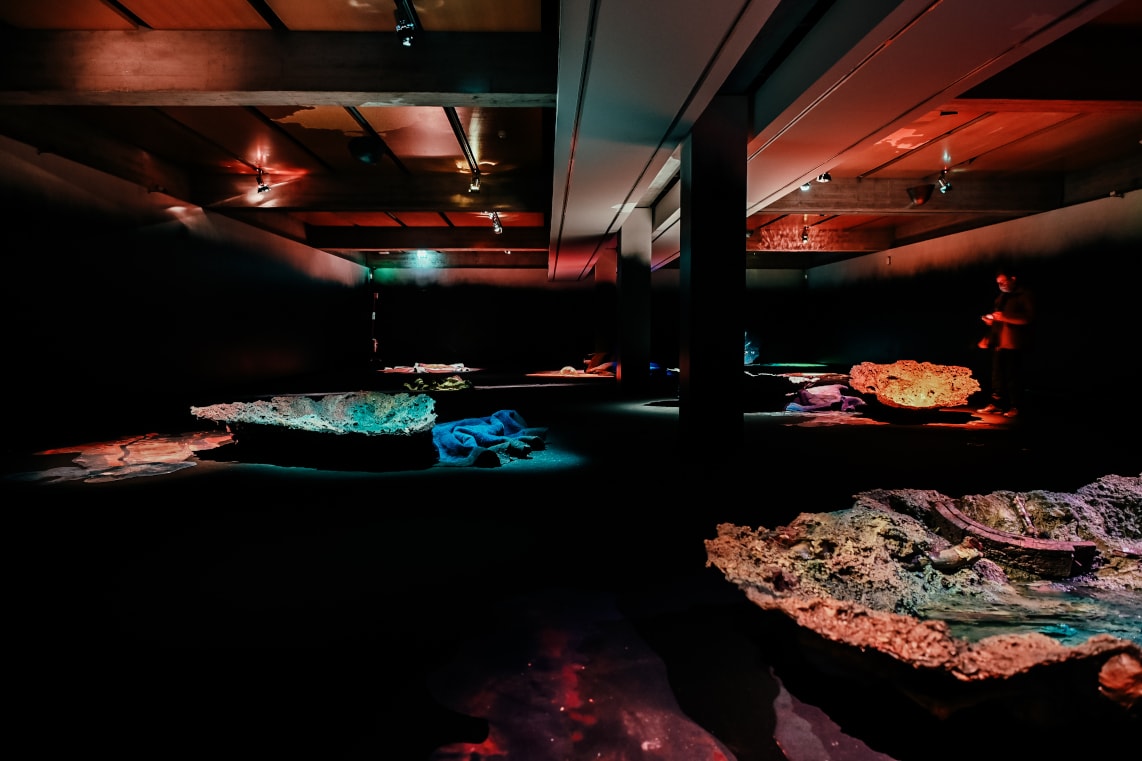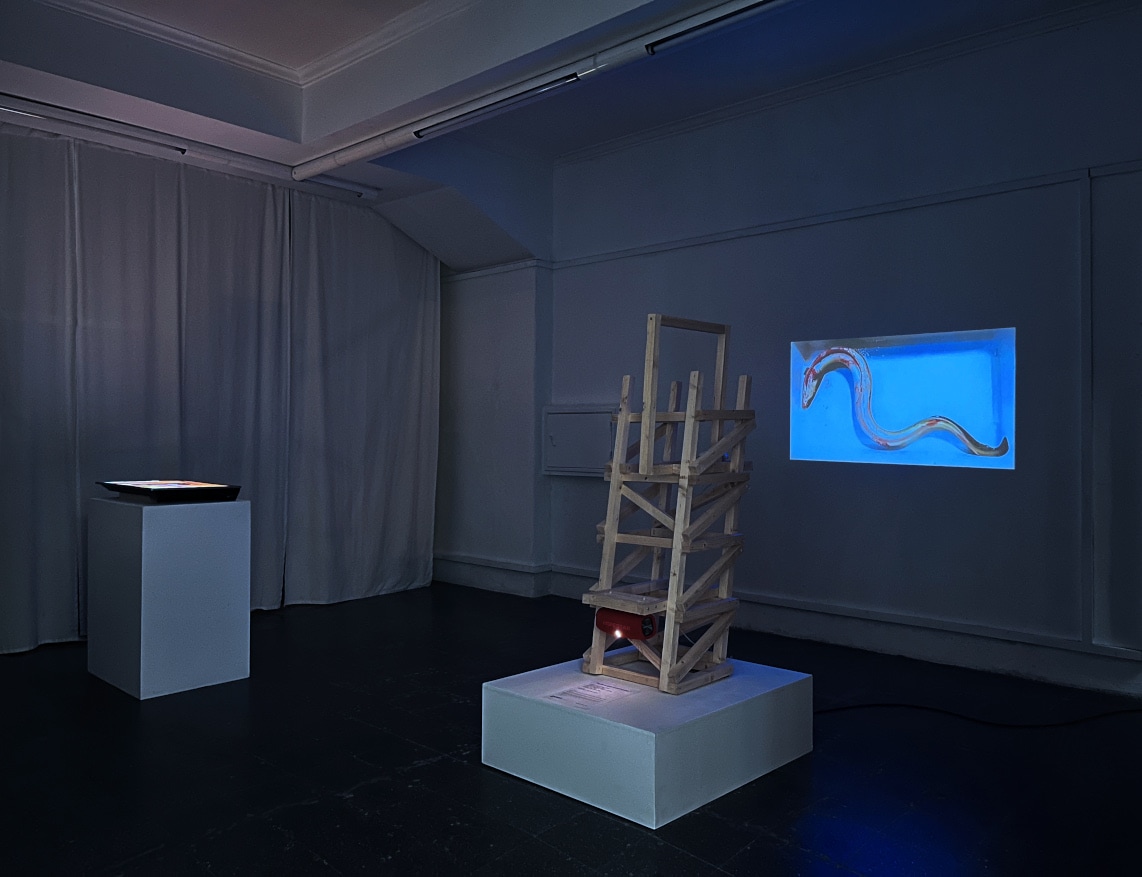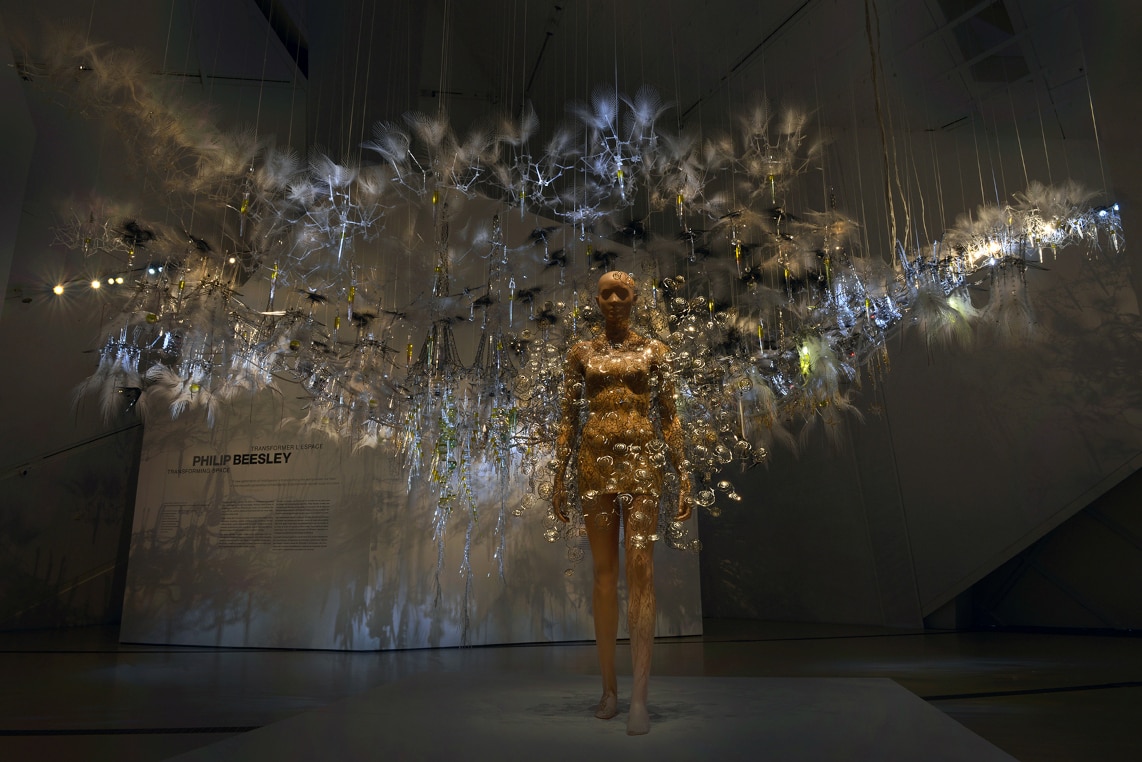“I couldn’t live without the radiant dawn, and the flood of brilliant colours around the setting sun…”
Philip Beesley[1]
An architect and interdisciplinary artist, Beesley has developed much of his work in collaboration with artists from different artistic fields. His creativity has grown in networks, presenting the results in large and complex buildings, installations, and sculptures.
His creative process is technology-focused, based on a rapidly expanding culture made up of responsive and interactive systems, yet inspired by an organic world and traditional techniques. His methodology is underpinned by the uncanny possibilities of digital technology which, by being ever more sophisticated, allows him to bridge the gap between the finesse and lightness of structures and the robustness required for rapid prototyping. In fact, his works have the same characteristics as nature: large, networked surfaces that replicate and connect identical elements. The pattern proliferation is reminiscent of the organic world’s growth process. It is no accident that several of his works are directly incorporated into living nature. For example, Haystack Veil[2] (1997) e Erratics Net (1998): the former is a mesh constructed from some 30.000 branches cut over a moss- and lichen-covered cliff on the Maine Atlantic coast; the latter is a giant wire net on the Nova Scotia coast that helped the local vegetation grow. Beesley’s art gathers and thinks together with nature about the processes of organising multiplicity. For us, this is reminiscent of Deleuze and Guattari’s rhizome[3], i.e., the process of connecting multiplicity by itself. This is a process that opens up and moves in all directions and other experimentations, in a pulsating way, growing where there is room, flourishing where it can, setting up its environment.
These works also use geotextiles, materials used in such diverse and antagonistic sectors as construction and horticulture. This stresses the significance of a harmonious relationship between nature and human creation, strengthening the emotional conditions in the understanding and enjoyment of art. The natural, the human, the synthetic, the technological coexist and contaminate each other to blur material and psychological borders, stimulating transdisciplinary creation with craftsmen, biologists, technicians, designers, or musicians. Collaborations with Iris Van Harpen and Salvador Breed, among others, explore the immersive sculptural possibilities that arise from a research work between art, science, and technology.
Beesley’s ongoing research into architecture and a practice focused on the organic dimension of his works has given him a pioneering place in creating a living, functional architecture, and sculptures, requiring more than an interaction with the individual. The artist’s research is deeper and more complex, as the organic living dimension of his architecture is intended to open up stunning possibilities enabled by artificial intelligence at almost every design level to bring about highly interactive organic environments.
Grove (presented at the 17th International Architecture Exhibition – La Biennale de Venezia) blends architecture, music, and cinematography. The result is an environment between the real and the virtual, with conceptual and structural issues intrinsic to architecture, such as the sustainability issue of a coherent, strong, and resilient building, capable of self-renewal, but based on natural and dissipative forms. The passage from complex and interdependent natural systems to physical and virtual structures and environments predicts a future where the corporeal and the mental are joined with the physical and virtual space. There is a real immersion, as this is not just a physical world, but a multiverse in constant metamorphosis, where there are no stationary or closed territories.
The installation is an undulating, high canopy, formed by luminous clouds encrusted with glass balls infused with liquid on a screen in the shape of a swimming pool. On it a film is screened, surrounded by a forest of columns, which generate a spatial environment (multi-channel system). The film and soundscape recreate an experience of “living architecture”, where the film’s complex geometries change from inert crystalline minerals to emergent life forms. It is a process of constant metamorphosis, of inertia and movement, of death and life, following nature’s organic cycle that constantly regenerates between fragment and chaos. It is an installation that resulted from collaborative work with Warren du Preez, Nick Thorton Jones (film) and Salvador Breed (sound).
For Beesley, the architecture of the future develops in communion with flora, fauna, but also with the inert matter in nature. For centuries, cities had supposedly protective walls, but they formed a division and tension with the natural world to which we belong. This bred a delimited and rigid construction, in perpetual conflict, without nurturing a more open and inclusive world, where bodies and spirits can transform and regenerate, with profoundly healing qualities. In this sense, we can say that Beesley’s work expresses a holistic vision, where all things are interconnected. Its characteristics are thus ontologically dependent on this connection.
When asked about his architectural philosophy, the artist explains that it is based on the concept that modern buildings feature increasingly complex systems, where physical components are like flexible and responsive scaffolding. This creates an intelligent, interactive structure that is also tangible. In other words, ‘tangible awareness’ is developed, displaying the materials and their surroundings. The requirements for constructing a building are the same as those that give birth to life: the connection between interactive structures, information exchange and a kind of metabolism – architecture comes to life.
One of the most fruitful collaborations with other artists has been Beesley’s with designer Iris Van Harpen. She works with 3D textile materials and responsive design in the world of haute couture, and is also interested in the possibility of giving physical form to the intangible, such as vulnerability, femininity, or sensuality. The first collaboration took place in her Voltagecollection (2013), for which 3-D fabrics were designed that shaped a clothing concept that responded to the body’s movement through dynamic vibration. Technology and handwork, science and art, chaos and beauty, performance and nature, form and concept complement each other and provide consistency to the creative and collaborative process between the two artists. In 2018, the collaboration on Dome Dress allowed to create a bridge between Beesley’s exhibition (Transforming Space) and Van Harpen’s exhibition (Transforming Fashion), which took place at the Royal Ontario Museum. The designer’s dress is part of Beesley’s installation – Aegis. The inspiration lies in the idea of communicating materiality through air. It is the outcome of the fascination they both feel for materials and structures. And how the constant creative process of experimentation demands new thoughts about art, technology, and nature.
Aegis’ charming and immersive forest remains an interactive environment created by responsive mechanisms and microprocessors, part of a light, suspended, 3-D printed mesh structure. It breathes, changes, and learns from the visitors’ intervention. The floating environment around the dress and the viewers resembles the fluidity of the ethereal and transcendental world. It materialises into a material and resilient reality through a process of reification enabled by technology.
Through it all, Beesley’s living, experimental architecture operates by exploring the subtle phenomena and ever-volatile limits of current technology for a more expansive nature and art.
[1]“Philip Beesley, the divine technology”, interview with Philip Beesley by Lidia Ratoi. Clot Magazine, Feb 8. 2020. PHILIP BEESLEY, The Divine Technology | CLOT Magazine
[2] Work made in collaboration with Warren Seiling.
[3] Deleuze, Gilles and Guattari, Félix. Mille Plateaux. Paris: Éditions du Minuit, 1980.


